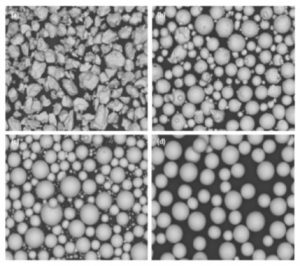Technical Newsletter vol.11 : Micro MIM technology can be further extended with Titanium
Micro MIM technology can be further extended with Titanium
In metal injection moulding(MIM, the metal powder as raw material ultimately defines the quality of the final product. This time we would like to especially introduce titanium powder as one kind of such metal powders.
Current state of metal powder
There are 855 metal powder manufacturers worldwide. About half are in North America and the other half are in Europe and the Asia-Pacific region (2013). The amount that these powder makers can produce in a year is considered to be 1.12 million tons, of which about 40% is used for powder metallurgy. There are three major methods of powder production: mechanical grinding, atomisation and chemical reaction. Although titanium powder can be manufactured by any of these methods, MIM generally applies small spherical particles, therefore atomisation powder is commonly used.
Why atomised powder is most suitable for MIM
The atomising method begins with melting the feedstock alloy. The liquid metal is poured into an atomisation chamber little by little while water or gas jets are symetrically positioned around the stream of liquid metal, solidifying the particles to obtain powder. It can be divided into water atomisation and gas atomisation depending on the coolant. Water atomisation is often applied to produce metal powders that are relatively resistant to oxidation, such as stainless steel, from the viewpoint of productivity. However, gas atomisation is employed to produce highly active metal powders such as titanium. Argon gas is used as a coolant in the titanium production.
Pic. 1 shows SEM images of titanium alloy Ti-6Al-4V. These are powders produced by (a) Hydride-dehydride process (b) electrode induction melting inert gas atomisation EIGA, (c) plasma atomisation, and (d) plasma rotating electrode process. Other than (a), the gas atomisation method is applied, however, the powder obtained by each method has different particle morphologies.

Pic. 1 SEM observation record of Ti-6Al-4V powder: shape varies depending on manufacturing method.
Excerpt from : Johnson Matthey Technology Review, Introduction to the Additive Manufacturing Powder Metallurgy Supply Chain, J. Dawes et al. 2015, 59(3), p. 243-256.
In: Fukuda Metal Foil and Powder Co., Ltd., Volume 65, Issue 4 „Special Steel“, July 1st, 2019
https://www.fukuda-kyoto.co.jp
Latest technologies in metal powder are applied in Micro MIM
In metal injection mould or MIM, the use of spherical powder improves the flowability during moulding, so more complex shapes can be manufactured. Furthermore, if the particle size distribution range is spread to a finer degree, deformation during the sintering process is suppressed. However, fine powders have problems such as greatly reducing the flowability and causing unnecessary reaction with the binder frequently due to the increment of surface area. Micro MIM Japan and Taisei Kogyo have overcome the above problems applying our original µ-MIM technology. In our production, (b) EIGA and (c) plasma atomised powder are employed, which are ideal for MIM production. µ-MIM technology realises mass production of complex micro titanium component parts while fulfilling mechanical properties.
COLUMN

Hi, I am David and in charge of business development for the European market. I just moved to Offenburg (southwestern Germany), where our european office is located. As I have lived in Japan for about 7 years, I consider the country as my second home. In Tokyo I have been living the metropolitan life, so it was a challenge to get used to a more „countryside“ way of live, but moving between different cultures I learned to adapt to new enviroments quickly. I am looking forward to explore the nearer surroundings with my bicycle, and in winter I hope to get the chance to go snowboarding in the mountains. If you have any questions regarding Japan, please do not hesitate to contact me in English or German (check our website for contact details). Thank you!
*Remark : This newsletter was originally published on July 8, 2019
